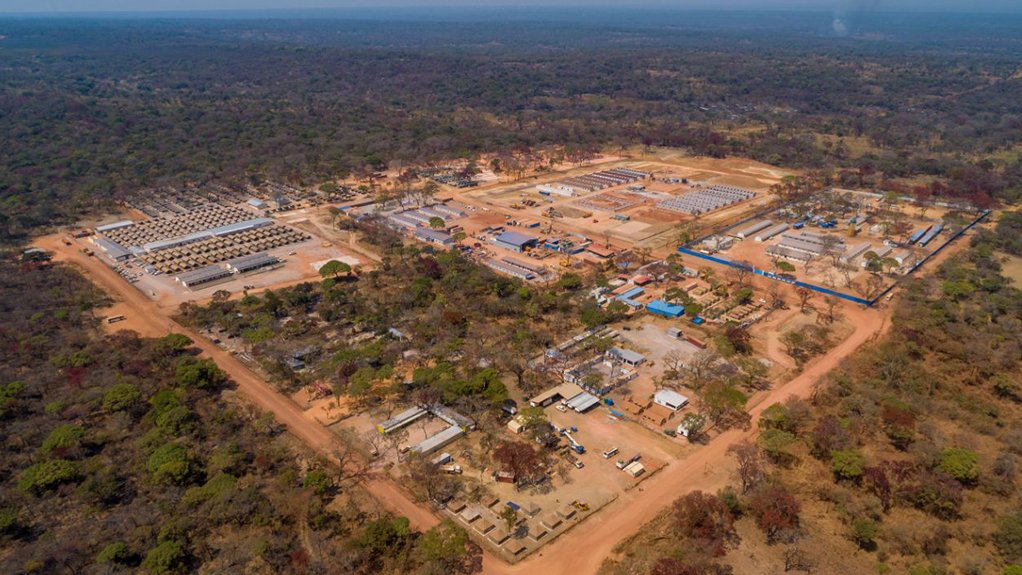
+27 11 441 1111
SRK House, 265 Oxford Road, Illovo, 2196, South Africa

Kamoa-Kakula copper project, Democratic Republic of Congo – update


Name of the Project
Kamoa-Kakula copper project.
Location
The Kolwezi district of Lualaba province, in the Democratic Republic of Congo (DRC).
Project Owner/s
Kamoa Copper, a joint venture (JV) between base and precious metals developer Ivanhoe Mines, with 39.6% ownership; Zijin Mining Group, with 39.6% ownership; Crystal River Global, with 0.8% ownership; and the DRC government, with 20% ownership.
Project Description
Ivanhoe Mines has announced outstanding economic results in the independent integrated development plan for the tier-one Kamoa-Kakula copper project.
The Kamoa-Kakula Integrated Development Plan 2020 comprises three development scenarios: the Kakula definitive feasibility study (DFS), the Kakula-Kansoko prefeasibility study (PFS) and the Kamoa-Kakula preliminary economic assessment (PEA).
Kakula
The Kakula DFS proposes the development of a Stage 1, six-million-tonne-a-year underground mine and surface processing complex at the Kakula deposit, with a capacity of 7.6-million tonnes a year built in two modules of 3.8-million tonnes a year. For this option, 110-million tonnes will be mined at an average grade of 5.22% copper producing 8.5-million tonnes of high-grade copper concentrate and containing about 10.8-billion pounds of copper.
Kakula-Kansoko
The Kakula-Kansoko 2020 PFS evaluates the development of mining activities at the Kansoko deposit in addition to the Kakula mine, initially at a rate of 1.6-million tonnes a year, to supply the concentrator at Kakula, eventually ramping up to six-million tonnes a year as the reserves at Kakula are depleted.
Kamoa-Kakula
The Kamoa-Kakula 2020 PEA assesses an additional development option of mining several deposits on the Kamoa-Kakula project as an integrated, 19-million-tonne-a-year mining, processing and smelting complex, built in multiple stages.
An initial six-million-tonne-a-year mining operation will be established at the Kakula mine on the Kakula deposit, which will be followed by a separate six-million-tonne-a-year mining operation at the Kansoko mine. A third six-million-tonne-a-year mine will then be established at the Kakula West mine, in addition to a fourth initial mine in the Kamoa North area operating at one-million tonnes a year. The processing plant will be built in five modules of 3.8-million tonnes a year, with an ultimate capacity of one-million tonnes a year.
As the resources at the Kakula, Kansoko and Kakula West mines are mined out, production will begin sequentially at five other mines in the Kamoa North area to maintain throughput of 19-million tonnes a year to the existing concentrator and smelter complex.
Each mining operation is expected to be a separate underground mine, with a shared processing facility and surface infrastructure located at Kakula. Material will be transported to the Kakula processing complex using a system of overland conveyors. Included in this scenario is the construction of a direct-to-blister copper smelter with a capacity of one-million tonnes of copper concentrate a year.
Potential Job Creation
Once the two processing plants at Kakula are operating, Ivanhoe expects to employ almost 2 000 permanent Kamoa employees.
Net Present Value/Internal Rate of Return
The Kakula DFS yields an after-tax net present value (NPV), at an 8% discount rate, of $5.5-billion and an internal rate of return (IRR) of 77% over a 21-year mine life, with a payback of 2.3 years.
The Kakula-Kansoko PFS yields an after-tax NPV, at an 8% discount rate, of $6.6-billion and an IRR of 69% over a 37-year mine life, with a payback of 2.5 years.
The Kamoa-Kakula PEA yields a potential after-tax NPV, at an 8% discount rate, of $11.1-billion and an IRR of 56% over a mine life of more than 40 years, with a payback of 3.6 years.
Capital Expenditure
The Kakula DFS estimates peak funding at $775-million, remaining initial capital costs at $646-million and expansion capital costs at $594-million.
The Kakula-Kansoko PFS estimates peak funding at $848-million, remaining initial capital costs at $695-million and expansion capital costs at $750-million.
The Kamoa-Kakula PEA estimates peak funding at $784-million, remaining initial capital costs at $715-million and expansion capital costs at $4.46-billion.
Planned Start/End Date
The initial production of copper concentrate at the Kakula mine processing plant began on May 25, 2021, and achieved commercial production on July 1, 2021.
The expansion of the Kakula processing plant will be brought forward from the first quarter of 2023 to the third quarter of 2022.
Latest Developments
A debottlenecking plan for the Kamoa-Kakula project has been approved by Ivanhoe’s board and will increase the combined design processing capacity of the Phase 1 and Phase 2 concentrator plants by about 21%.
Once steady-state production is achieved at both concentrators, the plants will be able to process 9.2-million tonnes of ore, up from the previously planned 7.6-million tonnes a year, Ivanhoe co-chairpersons Robert Friedland and Yufeng “Miles” Sun said on February 22.
The debottlenecking initiative is expected to increase Kamoa-Kakula’s Phase 1 and Phase 2 copper output to more than 450 000 t/y by the second quarter of 2023, thereby positioning the project as the world’s fourth-biggest copper producer.
Construction of Kamoa-Kakula’s 3.8-million-tonne-a-year Phase 2 concentrator plant is nearing completion, with early-stage commissioning activities under way. Hot commissioning of the concentrator, with first ore and initial copper concentrate production, are both on track for April.
Ivanhoe Mines DRC projects head Steve Amos has said that after successfully operating the Phase 1 concentrator for more than eight months, Ivanhoe has identified several relatively minor modifications to the concentrator that should increase ore throughput from the current design of 475 t/h to 580 t/h.
“These modifications include increasing the diameter of a number of pipes; replacing a number of motors and pumps with larger ones; and installing additional flotation, concentrate-thickening, concentrate-filtration and tailings disposal capacity.”
Ivanhoe expects the debottlenecking project to cost about $50-million and take about 12 months to complete.
“These modifications will allow the team to consistently operate the concentrator plant at the increased throughput without compromising plant availability, copper recovery or copper concentrate grade,” Amos adds.
Engineering design is under way and procurement of long-lead items has started.
The Phase 1 concentrator is operating at a throughput that is more than its 3.8-million-tonne-a-year design capacity, by more than 22%, with 112% of design throughput achieved in January.
Copper recoveries above 87% are also being consistently achieved, which more than the design recovery of 85.6%, depending on feed grade, with January’s recoveries being about 2.7% higher.
Despite the Phase 1 concentrator incurring significant downtime for critical incorporation and changes required for the commissioning of the Phase 2 concentrator, the copper-in-concentrate produced in January totalled 18 824 t – almost the same as the record of 18 853 t achieved in December 2021.
Further, Ivanhoe has reported that January’s impressive operating performance of the Phase 1 concentrator is continuing, with a new daily concentrator record set on February 7, with 13 498 t milled.
Kamoa Copper CEO Mark Farren has said that because the underground mine development and ore production are progressing well ahead of schedule, the plant expansion will enable the operations team to process significantly more high-grade copper ore directly from the Kakula mine in the years ahead.
“Our orebody has a huge advantage in allowing us to adapt our mining cutoff to mine larger tonnages very efficiently while maintaining grades above a desired level.
“The expansion also provides the team with the flexibility to use our surface stockpiles, for which the mining is already paid for, that totalled more than 4.4-million tonnes grading [at] 4.61% copper at the end of January,” he adds.
Engineering and early works for the Phase 3 expansion – including a new boxcut and twin declines to access new mining areas – are also progressing quickly.
An updated prefeasibility study, including the Phase 3 expansion, is expected in the third quarter of this year.
Ivanhoe has reported that a third, significantly larger concentrator, is being designed and is expected to be commissioned in the fourth quarter of 2024.
Also under way are early works on a direct-to-blister flash smelter, with a nameplate capacity of 500 000 t/y of about 99%-pure blister copper, at Kamoa-Kakula that will incorporate modern technology supplied by Metso Outotec.
Key Contracts, Suppliers and Consultants
DFS/PFS/PEA:
OreWin (overall report preparation, mining, logistics, power and economic analysis); China Nerin Engineering (smelter design); DRA Global (mine surface infrastructure and metallurgical processing); Epoch Resources (tailings storage facility design); Golder Associates (hydrology models and recommendations); KGHM Cuprum R&D Centre (technical adviser on certain mining methods and geotechnical); Outotec Oyj (smelter technology); Paterson and Cooke (paste backfill plant design and surface/underground paste distribution system); SRK Consulting (mine geotechnical recommendations); Stantec Consulting International (mining and mineral reserves); Wood (mineral resources estimation); Kamoa Copper and SNEL, together with Stucky SA (engineering procurement and construction management – Turbine 5); Voith Hydro (contractor Turbine 5); China Nerin Engineering (basic engineering contract for the smelter); and Metso (smelter technology).
Contact Details for Project Information
Ivanhoe Mines, tel +1604 688 6630 (North America), +27 11 088 4300 (South Africa) or email info@ivanhoemines.com.


